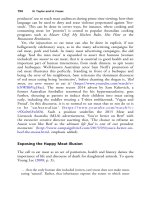The palgrave international handbook of a 211
Bạn đang xem bản rút gọn của tài liệu. Xem và tải ngay bản đầy đủ của tài liệu tại đây (38.5 KB, 1 trang )
206
A. Nurse
collecting is a direct form of animal abuse given that its consequence is
termination of a nonhuman animal life.
The Nature of Animal Collecting
The focus of this chapter is deliberate, intentional collecting as a form of
animal abuse. Thus this chapter distinguishes between hoarders, who may
well collect animals through ‘good’ intentions but will inadvertently commit animal abuse, and those whose intent is collection of an animal with
disregard for animal life or an active intent to cause animal abuse via
killing.
Hoarding and neglect are dealt with elsewhere in this volume and so are
only briefly referred to in this chapter. Previous research (Nathanson 2009,
p. 307; Nurse 2013a, p. 93) identifies hoarding as an extreme form of
passive animal harm which may initially be the result of good intentions
gone awry, albeit indicating the serious consequences of collecting and
neglect. By contrast, active animal harm consists of deliberate and intentional harm caused to animals (Daugherty 2005). In the case of collecting
activity, such active cruelty indicates elements of malicious intent towards
nonhuman animals on the part of the offender. This activity may be an
indicator of psychological factors such as a predisposition towards cruelty
(Ascione 1993; Boat 1995) and may also indicate that an abuser commits
other forms of abuse within the home such as spousal or child abuse
(Schleuter 1999; Turner 2000). Active animal collection, of the kind
typified by the compulsive egg collector or acquirer of taxidermy specimens
and sport trophies, represents a different kind of behaviour from hoarding
or passive neglect. Here, the end result and arguably the intent of collecting
activity is the death of a nonhuman animal to serve the collecting need.
Thus egg collectors, quite literally flush away an animal life in order to
acquire their ‘trophy’ (discussed further below), while taxidermy and sport
hunting trophy collectors employ speciesism (Beirne 2007; Sollund 2008)
objectifying animals in order to suit their collecting needs and neutralise
the cruelty inherent in their actions. Animal life is thus simply a barrier to
their obtaining the object of their desire and abusing animals becomes a
tool to facilitate their trophy acquisition. Collecting activity thus requires
negating the animal abuse and harm involved as offenders take an anthropocentric view of nonhuman animals as existing only to serve human needs
or desires.









